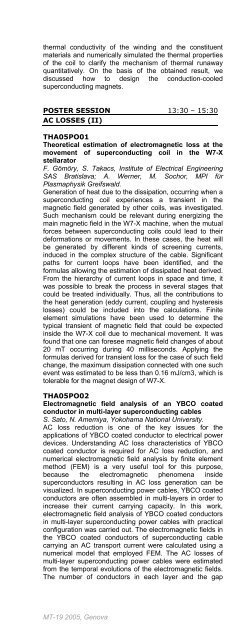Click here to download the abstract booklet in pdf format - MT19 - Infn
Click here to download the abstract booklet in pdf format - MT19 - Infn
Click here to download the abstract booklet in pdf format - MT19 - Infn
Create successful ePaper yourself
Turn your PDF publications into a flip-book with our unique Google optimized e-Paper software.
<strong>the</strong>rmal conductivity of <strong>the</strong> w<strong>in</strong>d<strong>in</strong>g and <strong>the</strong> constituent<br />
materials and numerically simulated <strong>the</strong> <strong>the</strong>rmal properties<br />
of <strong>the</strong> coil <strong>to</strong> clarify <strong>the</strong> mechanism of <strong>the</strong>rmal runaway<br />
quantitatively. On <strong>the</strong> basis of <strong>the</strong> obta<strong>in</strong>ed result, we<br />
discussed how <strong>to</strong> design <strong>the</strong> conduction-cooled<br />
superconduct<strong>in</strong>g magnets.<br />
POSTER SESSION 13:30 – 15:30<br />
AC LOSSES (II)<br />
THA05PO01<br />
Theoretical estimation of electromagnetic loss at <strong>the</strong><br />
movement of superconduct<strong>in</strong>g coil <strong>in</strong> <strong>the</strong> W7-X<br />
stellara<strong>to</strong>r<br />
F. Gömöry, S. Takacs, Institute of Electrical Eng<strong>in</strong>eer<strong>in</strong>g<br />
SAS Bratislava; A. Werner, M. Sochor, MPI für<br />
Plasmaphysik Greifswald.<br />
Generation of heat due <strong>to</strong> <strong>the</strong> dissipation, occurr<strong>in</strong>g when a<br />
superconduct<strong>in</strong>g coil experiences a transient <strong>in</strong> <strong>the</strong><br />
magnetic field generated by o<strong>the</strong>r coils, was <strong>in</strong>vestigated.<br />
Such mechanism could be relevant dur<strong>in</strong>g energiz<strong>in</strong>g <strong>the</strong><br />
ma<strong>in</strong> magnetic field <strong>in</strong> <strong>the</strong> W7-X mach<strong>in</strong>e, when <strong>the</strong> mutual<br />
forces between superconduct<strong>in</strong>g coils could lead <strong>to</strong> <strong>the</strong>ir<br />
de<strong>format</strong>ions or movements. In <strong>the</strong>se cases, <strong>the</strong> heat will<br />
be generated by different k<strong>in</strong>ds of screen<strong>in</strong>g currents,<br />
<strong>in</strong>duced <strong>in</strong> <strong>the</strong> complex structure of <strong>the</strong> cable. Significant<br />
paths for current loops have been identified, and <strong>the</strong><br />
formulas allow<strong>in</strong>g <strong>the</strong> estimation of dissipated heat derived.<br />
From <strong>the</strong> hierarchy of current loops <strong>in</strong> space and time, it<br />
was possible <strong>to</strong> break <strong>the</strong> process <strong>in</strong> several stages that<br />
could be treated <strong>in</strong>dividually. Thus, all <strong>the</strong> contributions <strong>to</strong><br />
<strong>the</strong> heat generation (eddy current, coupl<strong>in</strong>g and hysteresis<br />
losses) could be <strong>in</strong>cluded <strong>in</strong><strong>to</strong> <strong>the</strong> calculations. F<strong>in</strong>ite<br />
element simulations have been used <strong>to</strong> determ<strong>in</strong>e <strong>the</strong><br />
typical transient of magnetic field that could be expected<br />
<strong>in</strong>side <strong>the</strong> W7-X coil due <strong>to</strong> mechanical movement. It was<br />
found that one can foresee magnetic field changes of about<br />
20 mT occurr<strong>in</strong>g dur<strong>in</strong>g 40 milliseconds. Apply<strong>in</strong>g <strong>the</strong><br />
formulas derived for transient loss for <strong>the</strong> case of such field<br />
change, <strong>the</strong> maximum dissipation connected with one such<br />
event was estimated <strong>to</strong> be less than 0.16 mJ/cm3, which is<br />
<strong>to</strong>lerable for <strong>the</strong> magnet design of W7-X.<br />
THA05PO02<br />
Electromagnetic field analysis of an YBCO coated<br />
conduc<strong>to</strong>r <strong>in</strong> multi-layer superconduct<strong>in</strong>g cables<br />
S. Sa<strong>to</strong>, N. Amemiya, Yokohama National University.<br />
AC loss reduction is one of <strong>the</strong> key issues for <strong>the</strong><br />
applications of YBCO coated conduc<strong>to</strong>r <strong>to</strong> electrical power<br />
devices. Understand<strong>in</strong>g AC loss characteristics of YBCO<br />
coated conduc<strong>to</strong>r is required for AC loss reduction, and<br />
numerical electromagnetic field analysis by f<strong>in</strong>ite element<br />
method (FEM) is a very useful <strong>to</strong>ol for this purpose,<br />
because <strong>the</strong> electromagnetic phenomena <strong>in</strong>side<br />
superconduc<strong>to</strong>rs result<strong>in</strong>g <strong>in</strong> AC loss generation can be<br />
visualized. In superconduct<strong>in</strong>g power cables, YBCO coated<br />
conduc<strong>to</strong>rs are often assembled <strong>in</strong> multi-layers <strong>in</strong> order <strong>to</strong><br />
<strong>in</strong>crease <strong>the</strong>ir current carry<strong>in</strong>g capacity. In this work,<br />
electromagnetic field analysis of YBCO coated conduc<strong>to</strong>rs<br />
<strong>in</strong> multi-layer superconduct<strong>in</strong>g power cables with practical<br />
configuration was carried out. The electromagnetic fields <strong>in</strong><br />
<strong>the</strong> YBCO coated conduc<strong>to</strong>rs of superconduct<strong>in</strong>g cable<br />
carry<strong>in</strong>g an AC transport current were calculated us<strong>in</strong>g a<br />
numerical model that employed FEM. The AC losses of<br />
multi-layer superconduct<strong>in</strong>g power cables were estimated<br />
from <strong>the</strong> temporal evolutions of <strong>the</strong> electromagnetic fields.<br />
The number of conduc<strong>to</strong>rs <strong>in</strong> each layer and <strong>the</strong> gap<br />
between <strong>the</strong> conduc<strong>to</strong>rs were varied <strong>to</strong> study <strong>the</strong>ir<br />
<strong>in</strong>fluence on <strong>the</strong> AC loss of <strong>the</strong> cables. The numerically<br />
calculated AC losses were compared with <strong>the</strong> analytical<br />
values. This work was supported by <strong>the</strong> New Energy and<br />
Industrial Technology Development Organization (NEDO)<br />
as Collaborative Research and Development of<br />
Fundamental Technologies for Superconductivity<br />
Applications.<br />
THA05PO03<br />
Measurement of <strong>the</strong> Cryogenic Loss <strong>in</strong><br />
Superconduct<strong>in</strong>g Magnet System by us<strong>in</strong>g<br />
Calorimetric Method<br />
H. Kang, S.W. Park, M.C. Ahn, S.E. Yang, T.K. Ko, Yonsei<br />
University; S.Y. Choi, Sungkyunkwan University; C.J. Lee,<br />
B-Y. Seok, Electro-Mechanical Research Institute, Hyundai<br />
Heavy Industries, Co., Ltd; T.J. Kim, Seongnam<br />
polytechnic college; Y.S. Yoon, Ansan College of<br />
Technology.<br />
T<strong>here</strong> are some ways <strong>to</strong> measure <strong>the</strong> AC loss of<br />
superconduct<strong>in</strong>g material such as magnetization, transport<br />
current and calorimetric method. Especially, <strong>the</strong><br />
calorimetric method is very useful for measur<strong>in</strong>g <strong>the</strong> AC<br />
Loss of large scale superconduct<strong>in</strong>g magnet. The<br />
cryogenic loss of superconduct<strong>in</strong>g magnet system<br />
measured by mass flow meter (MFM) <strong>in</strong>cludes not only AC<br />
loss of superconduct<strong>in</strong>g magnet but also background loss<br />
such as conduction loss through current leads and<br />
electrical wires and radiation loss through cryostat. The<br />
cryogenic loss conta<strong>in</strong>s AC loss and background loss is<br />
very important <strong>in</strong> effective operation of cryogenic<br />
superconduct<strong>in</strong>g magnet system. To design and<br />
manufacture <strong>the</strong> applied superconduct<strong>in</strong>g magnet system<br />
such as superconduct<strong>in</strong>g transformer and fault current<br />
limiter, this <strong>to</strong>tal cryogenic loss should be taken <strong>in</strong><strong>to</strong><br />
consideration carefully. In this <strong>in</strong>vestigation, we fabricated<br />
<strong>the</strong> double pancake, solenoid and bifilar type<br />
superconduct<strong>in</strong>g magnet and measure <strong>the</strong> AC loss of<br />
<strong>the</strong>m. The cryogenic loss was experimentally measured<br />
and separated <strong>in</strong><strong>to</strong> background loss and AC loss. The<br />
experimentally measured background loss and AC loss<br />
were compared with <strong>the</strong> calculated losses by us<strong>in</strong>g simple<br />
heat equation and f<strong>in</strong>ite element method (FEM),<br />
respectively. These calorimetric measurement method and<br />
calculation method could be very useful <strong>to</strong> design <strong>the</strong><br />
applied superconduct<strong>in</strong>g magnet system with pert<strong>in</strong>ent loss<br />
<strong>to</strong> operate <strong>the</strong> superconduct<strong>in</strong>g magnet system reliably for<br />
a long time.<br />
THA05PO04<br />
Characteristics of Magnetization Loss and Shield<br />
Effect <strong>in</strong> Multi-stacked Tapes Accord<strong>in</strong>g <strong>to</strong> Stack<strong>in</strong>g<br />
Geometry<br />
J-K. Lee, Woosuk University; M. Park, H. Lim, H. Lee, G.<br />
Cha, Soonchunhyang University; S. Lee, Korea Electrical<br />
Eng<strong>in</strong>eer<strong>in</strong>g and Science Research Institute.<br />
AC loss is one of major <strong>to</strong>pics <strong>in</strong> large AC power high<br />
temperature superconduc<strong>to</strong>r(HTS) applications such as<br />
power tranformer, transmission cable and fault current<br />
limiter because it is closely related with operation<br />
efficiency. Multi-stacked tapes conduc<strong>to</strong>r should be used <strong>to</strong><br />
transport <strong>the</strong> large current <strong>in</strong> those power applications. A<br />
research of various arrangements of HTS tapes for multistacked<br />
tapes has been performed <strong>to</strong> <strong>in</strong>crease a capacity<br />
of transport current <strong>in</strong> HTS power applications. In this<br />
paper, we studied magnetization loss and shield effect by a<br />
different several arrangements of HTS(BSCCO) tapes such<br />
as Face-<strong>to</strong>-Face type, regular matrix type(m×2) and<br />
irregular matrix type. As a result, we get <strong>the</strong> result that <strong>the</strong><br />
MT-19 2005, Genova 132



